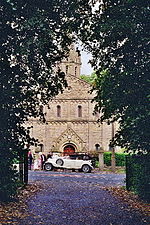- St Mark's Church, Blackburn
-
St Mark's Church, Blackburn St Mark's Church, Witton 
West front of St Mark's Church, BlackburnCoordinates: 53°44′38″N 2°30′30″W / 53.7439°N 2.5083°W OS grid reference SD 665 276 Location Buncer Lane, Blackburn, Lancashire Country England Denomination Anglican Website Parish of Christ the King History Founded 1836 Founder(s) Feilden family Dedication St Mark Consecrated 10 June 1838 Architecture Status Parish church Functional status Active Heritage designation Grade II* Designated 19 April 1974 Architect(s) Edmund Sharpe
E. G. Paley
Paley and AustinArchitectural type Church Style Romanesque Revival Groundbreaking 6 October 1836 Completed 1887 Specifications Materials Stone Administration Parish Christ the King Deanery Blackburn with Darwen Archdeaconry Blackburn Diocese Blackburn Province York Clergy Vicar(s) Rev Fleur Green Laity Churchwarden(s) Paul Blackledge
Mrs Rachel MatthewmanParish administrator Mrs Chris Culley St Mark's Church, Blackburn, is located in Buncer Lane, in the former parish of Witton, Blackburn, Lancashire, England. It is an active Anglican church in the deanery of Blackburn with Darwen, the archdeaconry of Blackburn, and the diocese of Blackburn.[1] Originally a separate parish, in 2005 it combined with the parish of St Luke with St Philip to form the Parish of Christ the King.[2] The church has been designated by English Heritage as a Grade II* listed building.[3]
Contents
History
St Mark's is one of the oldest churches in the Blackburn diocese, and was founded by the Feilden family, the largest landowners in Blackburn at the time. Joseph Feilden gave the land for the church, contributed £200 (£16,000 as of 2011)[4] towards its building and gave £50 (£4,000 as of 2011)[4] for the stained glass windows.[5] The church was built in 1836–38 to a Romanesque design by the Lancaster architect Edmund Sharpe.[6] It was one of Sharpe's first commissions and one of his early churches in Romanesque style.[7] The foundation stone was laid on 6 October 1836 by Joseph Feilden, and consecrated on 10 June 1838, although it may have been finished before the latter date. In 1870 the south transept was added. This was designed by Sharpe's successor in the practice, E. G. Paley, to serve as a mausoleum for the Feilden family.[8] Between 1881 and 1887 the church was restored by Paley and Austin who added the north transept and a vestry.[9]
Architecture
The architectural historian Nikolaus Pevsner considers that this is "One of the most interesting churches in Blackburn".[10] It is built in stone.[3] The exterior is divided into a grid pattern by lesenes (pilasters without a base or capital) and string courses. The west front is gabled and has a gabled porch. Along the sides of the church are two tiers of windows, the upper ones being smaller and narrower than the lower ones.[6] The plan of the church is cruciform.[8] It consists of a wide nave without aisles that suddenly contracts into a narrow chancel with a polygonal apse.[6] The north transept is five-sided, while the south transept is square.[3] The tower rises from the junction of the nave and the chancel. It is octagonal with a small gable rising from each face, and is surmounted by a spire.[6]
Internally there is a west gallery with a late 20th-century screen that is supported by cast iron columns. The main screen in the church is in Perpendicular style and dates from about 1920. The stained glass in the east window was designed by Thomas Willement and is dated 1838.[6]
See also
- List of architectural works by Edmund Sharpe
- List of ecclesiastical works by Paley and Austin
References
- ^ St Mark, Witton, Church of England, http://www.achurchnearyou.com/witton-st-mark/, retrieved 23 March 2010
- ^ Parish of Christ the King, Parish of Christ the King, http://www.parishofchristtheking.org.uk/index.html, retrieved 23 March 2010
- ^ a b c "Church of St Mark, Buncer Lane, Blackburn", The National Heritage List for England (English Heritage), 2011, http://list.english-heritage.org.uk/resultsingle.aspx?uid=1239292, retrieved 11 May 2011
- ^ a b UK CPI inflation numbers based on data available from Lawrence H. Officer (2010) "What Were the UK Earnings and Prices Then?" MeasuringWorth.
- ^ St Marks History, Parish of Christ the King, http://www.parishofchristtheking.org.uk/StMark'sHistory.html, retrieved 23 March 2010
- ^ a b c d e Hartwell & Pevsner 2009, p. 130.
- ^ Price 1998, pp. 41, 67.
- ^ a b Hughes 2010, pp. 115–116.
- ^ Price 1998, p. 80.
- ^ Pevsner 2002, p. 67.
Bibliography
- Hartwell, Clare; Pevsner, Nikolaus (2009) [1969], Lancashire: North, The Buildings of England, New Haven and London: Yale University Press, ISBN 978-0-300-12667-9
- Hughes, John M. (2010), Edmund Sharpe: Man of Lancaster, John M. Hughes (Although this is self-published, it is a scholarly work and fully referenced throughout. As of 2011 it is available only as a CD.)
- Pevsner, Nikolaus (2002) [1969], North Lancashire, The Buildings of England, New Haven and London: Yale University Press, ISBN 0-300-09617-8
- Price, James (1998), Sharpe, Paley and Austin: A Lancaster Architectural Practice 1836–1942, Lancaster: Centre for North-West Regional Studies, ISBN 1-86220-054-8
Categories:- Church of England churches in Lancashire
- Grade II* listed churches
- Grade II* listed buildings in Lancashire
- Romanesque Revival architecture in England
- 19th-century Anglican church buildings
- Anglican congregations established in the 19th century
- Religious buildings completed in 1887
- Diocese of Blackburn
- Edmund Sharpe buildings
- Paley and Austin buildings
- Buildings and structures in Blackburn
Wikimedia Foundation. 2010.
